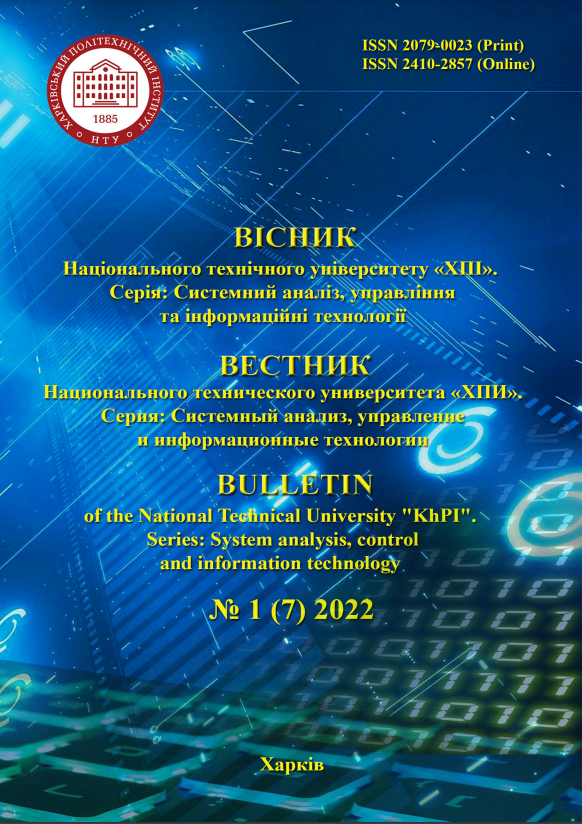CONSTRUCTION OF A MULTIVARIATE POLYNOMIAL GIVEN BY A REDUNDANT DESCRIPTION IN STOCHASTIC AND DETERMINISTIC FORMULATIONS USING AN ACTIVE EXPERIMENT
DOI:
https://doi.org/10.20998/2079-0023.2022.01.01Keywords:
least squares method, multivariate polynomial regression, normalized orthogonal polynomials of Forsythe, redundant representation, linguistic variable, limited active experimentAbstract
We present the methods for constructing a multivariate polynomial given by a redundant representation based on the results of a limited active experiment. We solve the problem in two formulations. The first is the problem of constructing a multivariate polynomial regression given by a redundant representation based on the results of a limited active experiment. The solution method is based on the previous results of Professor A. A. Pavlov and his students showing the fundamental possibility of reducing this problem to the sequential construction of univariate polynomial regressions and solving the corresponding nondegenerate systems of linear equations. There are two modifications of this method. The second modification is based on proving for an arbitrary limited active experiment the possibility of using only one set of normalized orthogonal polynomials of Forsythe. The second formulation refers to the solution of this problem for a particular but sufficient from the practical point of view case when an unknown implementation of a random variable is not added to the initial measurement results during an active experiment. This method is a modification of the solution method for the multivariate polynomial regression problem. Also, we used the main results of the general theory (which reduces the multivariate polynomial regression problem solving to the sequential construction of univariate polynomial regressions and solution of corresponding nondegenerate systems of linear equations) to consider and strictly substantiate fairly wide from the practical point of view particular cases leading to estimating the coefficients at nonlinear terms of the multivariate polynomial regression as a solution of linear equations with a single variable.
References
Ivahnenko A.G. Modelirovanie slozhnyh sistem. Informacionnyj podhod [Complex Systems Modeling. Informational Approach]. Kiev, Vyshha shkola Publ., 1987. 62 p.
Nastenko E., Pavlov V., Boyko G., Nosovets O. Mnogokriterial'nyj algoritm shagovoj regressii. Biomedychna inzheneriya i tekhnolohiya [Biomedical ingeneering and technology]. 2020, no. 3, pp. 48–53. doi: 10.20535/2617-8974.2020.3.195661
Draper N. R., Smith H. Applied Regression Analysis. 3rd edition. New York, John Wiley & Sons, 1998. 736 p.
Bol'shakov A. A., Karimov R. N. Metody obrabotki mnogomernykh dannykh i vremennykh ryadov: uchebnoe posobie dlya vuzov [Methods for processing multivariate data and time series: textbook for universities]. Moscow, Goryachaya liniya–Telekom Publ., 2007. 522 p.
Shahrel M. Z., Mutalib S., Abdul-Rahman S. PriceCop–Price monitor and prediction using linear regression and LSVM-ABC methods for e-commerce platform. International Journal of Information Engineering and Electronic Business (IJIEEB). 2021, vol. 13 (1), pp. 1–14. doi: 10.5815/ijieeb.2021.01.01
Satter A., Ibtehaz N. A regression based sensor data prediction technique to analyze data trustworthiness in cyber-physical system. International Journal of Information Engineering and Electronic Business (IJIEEB). 2018, vol. 10 (3), pp. 15–22. doi: 10.5815/ijieeb.2018.03.03
Isabona J., Ojuh D. O. Machine learning based on kernel function controlled gaussian process regression method for in-depth extrapolative analysis of Covid-19 daily cases drift rates. International Journal of Mathematical Sciences and Computing (IJMSC). 2021, vol. 7 (2), pp. 14–23. doi: 10.5815/ijmsc.2021.02.02
Babatunde G., Emmanuel A. A., Oluwaseun O. R., Bunmi O. B. Precious A. E. impact of climatic change on agricultural product yield using k-means and multiple linear regressions. International Journal of Education and Management Engineering (IJEME). 2019, vol. 9 (3), pp. 16–26. doi: 10.5815/ijeme.2019.03.02
Pavlov O. A., Holovchenko M. M., Revych M. M. Metod otsinky koefitsiyentiv pry liniynykh chlenakh bahatovymirnoyi polinomial'noyi rehresiyi, zadanoyi nadlyshkovym opysom. [Method for estimating coefficients for linear terms of multidimensional polynomial regression given by redundant description] Adaptyvni systemy avtomatychnoho upravlinnya: mizhvidomchyy nauk.-tekhn. zbirnyk [Adaptive systems of automatic control: interdepartmental scientific and technical. collection]. Kyiv, KPI Publ., 2022, vol. 1, no. 40. (in print)
Pavlov A., Holovchenko M., Mukha I., Lishchuk K. Mathematics and software for building nonlinear polynomial regressions using estimates for univariate polynomial regressions coefficients with a given (small) variance. Lecture Notes on Data Engineering and Communications Technologies. 2022, vol. 134, pp. 288–303. doi: 10.1007/978-3-031- 04812-8_25
Pavlov A. A. Estimating with a given accuracy of the coefficients at nonlinear terms of univariate polynomial regression using a small number of tests in an arbitrary limited active experiment Visnyk Nats. tekhn. un-tu "KhPI": zb. nauk. pr. Temat. vyp.: Systemnyy analiz, upravlinnya ta informatsiyni tekhnologiyi [Bulletin of the National Technical University "KhPI": a collection of scientific papers. Thematic issue: System analysis, management and information technology]. Kharkov, NTU "KhPI" Publ., 2021, no. 2 (6), pp. 3–7. doi: 10.20998/2079-0023.2021.02.01
Hudson D. J. Statistics Lectures, Volume 2: Maximum Likelihood and Least Squares Theory. CERN Reports 64(18). Geneva, CERN, 1964. (Russ. ed.: Hudson D. Statistika dlja fizikov: Lekcii po teorii verojatnostej i jelementarnoj statistike. Moscow, Mir Publ., 1970. 296 p.). doi: 10.5170/CERN-1964-018
Downloads
Published
How to Cite
Issue
Section
License
LicenseAuthors who publish with this journal agree to the following terms:
- Authors retain copyright and grant the journal right of first publication with the work simultaneously licensed under a Creative Commons Attribution License that allows others to share the work with an acknowledgement of the work's authorship and initial publication in this journal.
- Authors are able to enter into separate, additional contractual arrangements for the non-exclusive distribution of the journal's published version of the work (e.g., post it to an institutional repository or publish it in a book), with an acknowledgement of its initial publication in this journal.
- Authors are permitted and encouraged to post their work online (e.g., in institutional repositories or on their website) prior to and during the submission process, as it can lead to productive exchanges, as well as earlier and greater citation of published work (See The Effect of Open Access).


